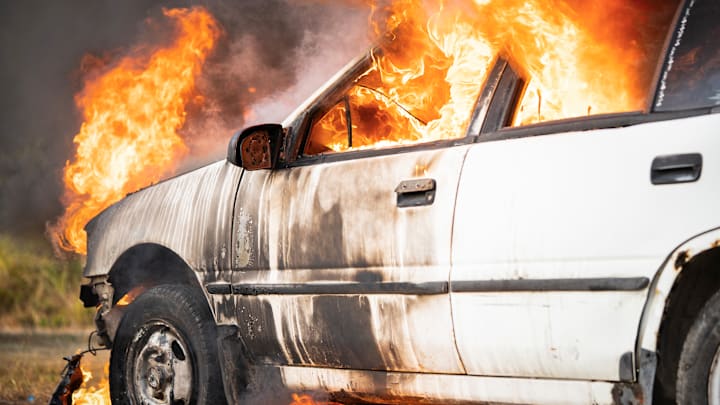As any Fast and Furious movie will tell you, irresponsible driving can lead to all kinds of vehicular mayhem, from plunging off the Hoover Dam to being clobbered by a car dragging a bank vault. In extreme cases, cars can burst into fireballs, as though everything from the seats to the radio dials were made of extremely flammable material.
While car fires can occasionally happen in real life, it’s usually far less dramatic, and crashing isn’t the only cause.
- Are Car Fires Common?
- What Causes Vehicle Fires?
- Are Electric Vehicles More Likely to Catch Fire?
- Get Answers to More Big Questions:
Are Car Fires Common?
First, vehicle fires are extremely rare. According to the National Fire Protection Association, an average of 117,400 car fires were reported annually between 2013 and 2017. That may sound like a lot, but given the number of cars being driven at the time—about 261 million—drivers had about a .04 percent chance of being engulfed in flames. Though that’s crept up a bit recently—the NFPA logged over 200,000 fires in 2023—it’s still relatively low.
What Causes Vehicle Fires?
It’s definitely possible, however. Vehicles have everything needed for a fire; there’s fuel (gasoline), an ignition source (a wayward battery or another overheated component), and oxygen. Fires typically start with some type of electrical issue, like cracked or damaged wiring. (This can come from wear or even rodents chewing on parts.) Given access to a leaky fuel source or other flammable ingredient, a fire can start.
You don’t necessarily need fuel, though. A hot catalytic converter with a missing heat shield can spark up nearby grass, or a lack of coolant can prompt an engine to overheat. Crashes or accidents can accelerate or cause these issues, damaging electrical components and fuel tanks. But a crash isn’t necessary: The NFPA estimates only 5 percent of vehicle fires had an accident as a contributing factor. A car could, in theory, go up in smoke while parked.
Are Electric Vehicles More Likely to Catch Fire?
According to Consumer Reports, hard data on the frequency of fires in electric vehicles (EVs) compared to fuel engines is still scant. Though it’s believed to be far less common, there are also fewer EVs on the road. EV fires tend to stir up more concern because they’re often tougher to put out thanks to lithium-ion batteries, which have flammable cells prone to chain reactions. Damage to one can mean damage to others.
Should you ever find yourself in a car that’s smoking or in flames, you should pull over, turn off the engine, and get at least 100 feet away. Don’t linger to grab anything, and don’t pop the hood. Keeping up with regular car maintenance by checking fluids and components should greatly reduce the chances of disaster striking. You should also avoid parking in tall grass and keep your windows open when transporting gas in the passenger area to prevent a build-up of fumes.
You may have noticed that vehicles tested in crash simulations don’t usually result in fires; that’s because testing sites can take precautions not available to ordinary drivers. They might use hydraulics to propel the car, removing the need for fuel and the potential for a hot engine to ignite it. But they still fill the tank, typically with a solvent similar to gasoline, to test for leaks and hopefully prevent more fire-prone vehicles from remaining on the streets.
